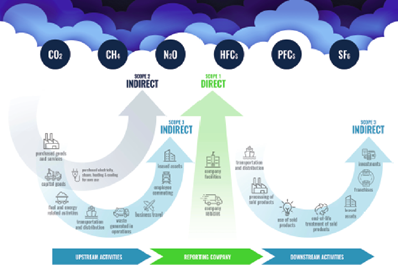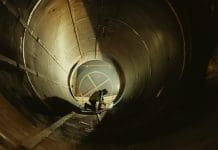The technology is already in place to meet net zero targets – collaboration, interoperability and a change of mindset to value the entire building lifecycle will be key to achieving them, says Mark Coates, international director of public policy and advocacy at Bentley Systems
The UK will not achieve its 2050 carbon emissions targets if it continues to follow the current stuttering path. Picking off the low-hanging fruit – LED lighting, promoting electric cars or changing energy provider – will be insufficient.
The built environment seems a natural place to start, an industry that contributes to around 40% of global carbon emissions. Typically, over 80% of the emissions are found within the operational phase of a building’s lifecycle and the remaining 20% are split across design and build phase and the decommission/end-of-life phase.
If we take the example of a hospital from an operational perspective, many different asset fields contribute to its overall carbon footprint. They include catering, waste management, cleaning, transport, heating/cooling, lighting, fridges and medical equipment, which are spread across the physical hospital footprint of buildings, wings, floors, rooms and theatres.
In the case of the NHS, it is estimated that over 60% of its carbon footprint is within Scope 3: supply chain and partners. Although carbon emission figures may differ for other organisations, trends are generally similar, so our area of focus should be clear: the operational phase. We must also focus on ensuring that primary assets and services, as well as their supply chain, are appropriately measured, managed, controlled and improved.

Data, data and more data
All too often, static and active data from disjointed processes and disparate, unconnected solutions are kept in silos or not maintained throughout the whole lifecycle. This disconnect prevents data from being used for continuous improvement.
For new build capital projects, static data is usually held in CAD, BIM, CDEs (common data environments) and asset management (CAFM, CMMS) solutions. Active data usually comes from sources – such as IoT sensing, BMS and SCADA solutions – predominately found once the asset is in use in the operational phase.
But the importance of interoperability, or at the very least defining a migration roadmap to more modern systems better suited to an interoperable environment, must be stressed. Gap analysis can help us better understand incumbent technology, people and processes, helping deploy and integrate a suitable smart building environment.
Only when these projects are supported by an ecosystem of Subject Matter Experts (SMEs) for disciplines that share the same vision and objective of an interoperable environment generating reusable data for the client’s desired business outcomes can we hope to achieve Net Zero Carbon (NZC) outcomes.
Sharing and merging data from different solutions is critical. For example, why heat and light a room if it’s not being used? This scenario requires static data -such as room, dimensions and location – and active data – such as temperature, energy consumption and occupancy.
The positive impact on NZC targets would be extremely significant if owner-operators and engineering, architect and construction (AEC) partners adopted open interoperable solutions to ensure shared, non-siloed data can be used to achieve desired business outcomes such as NZC.
Why do solutions need to work together? Simply put, data-driven decision-making opens up countless possibilities to reduce a carbon footprint – but we can’t get there by working as an island. We need to bring together static and active data to form part of smart sustainability algorithms targeted to reduce direct and indirect emissions.
The right questions of who, why, when and how assets and locations are being used must be asked and applied to merged data sources to obtain insights and drive actions and continuous improvement.
Simon Roberts, managing director at Mercateo UK & Ireland, said: “The digitally integrated approach we have developed with SRO and our eco-partners is a potential game-changer for sustainability within the built environment.
Through proper use of data collected and exploited throughout the whole asset lifecycle, we can now bring together smart asset management and e-procurement solutions to automate the supply chain process from ‘need identified’ using IoT on the asset, through to ordering parts from selected sustainable suppliers, to managing the maintenance work-orders.”
Collaboration and skillsets
But as different software and subject matter experts are needed throughout an asset’s lifecycle, bringing together different companies and their respective software/hardware and services and accessing their data can prove challenging.
Skillsets from traditional AEC organisations are often only found in one domain – such as design or build – and do not widen to consider the much larger operational impacts that a true smart sustainable building must conform to.
Addressing interoperability using open standards of key solutions used across the whole asset lifecycle will ensure that data is not lost or duplicated. It will also ensure that data can be augmented and shared as the project moves through the design, build, and operational phases.
Using an ecosystem of organisations, each specialising in the different solutions needed across the whole asset lifecycle of a built environment project, ensures modular open interoperable solutions and that helps the client avoid the risk of falling into closed, proprietary solutions where they risk vendor lock-in.
Interoperability enables “best in class” solutions that can be easily swapped in or out if deemed no longer fit for purpose. This approach also supports economic sustainability, as it allows multiple organisations to participate and contribute.
The good news is that there are organisations undertaking this approach.
Amanda Gomersall, general manager of corporate services and real estate at Leeds Teaching Hospital Trust, says: “The design and build capital project team, E&FM, and other internal stakeholders are working collaboratively and feeding into a roadmap that will bring together data from new build and legacy systems, within three to five years.
By having access to the right data and information, we can attain optimal efficiencies, which will help us achieve our net zero targets and become carbon neutral by 2040.”
Professor Chris Gorse of Leeds Beckett University agrees: “The integration of digital assets and resources throughout the whole asset lifecycle is essential. The luxury of assuming buildings operate as designed is insufficient.
The lack of consistent and recognised metrics is prohibiting clients to invest due to inability to justify or prove business cases. As such, Leeds Beckett University will be creating an ‘exemplar’ environment capable of identifying, measuring and promoting opportunities and innovation in CO2 emission reductions and clinical health care outcomes.”

Achieving net zero
Achieving net zero emissions targets is going to be challenging for all asset intensive organisations. There is no silver bullet or easy fix, and the owner-operators and wider AEC industry need to take leaps and bounds or else fail for their organisations and the planet.
But innovation isn’t just about technology. It’s also about how technology, people and processes are applied to a problem. There are certain areas in which a change in mindset is needed to support these leaps and bounds – from collaboration and an insufficient digital skillset to early operations engagement and the interoperability of solutions producing non-siloed data.
NZC goals by 2050 are perfectly feasible. We have all the necessary technology and other pieces of the puzzle available to us. Collaborate, ensure interoperability across the whole asset lifecycle and stopping design-to-handover-type thinking will be key in reaching these targets.
Mark Coates
International director of public policy and advocacy
Bentley Systems
Tel: +353 1 436 4600
Twitter: @bentleysystems
LinkedIn: Bentley Systems
YouTube: BentleySystems














